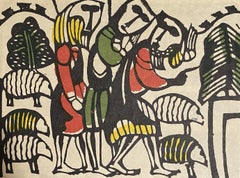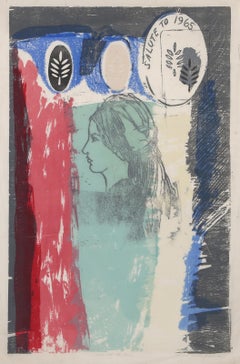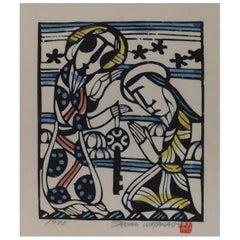Sadao Watanabe. Abstract Prints
Japanese, 1913-1998
Sadao Watanabe, born in Tokyo in 1913, used the medium called kappazuri ("stencil printing"), a technique related to 'katazome' ("stencil dyeing"). 'Katazome' is said to have originated in Okinawa (the method there was called 'bingata'). The paper most widely used in Japan for stencil printing is called 'shibugami', made from several layers of 'kozo' paper laminated with persimmon tannin. The sheets are dried and smoke-cured to strengthen them and make them flexible and waterproof. Once the artist makes a drawing, it is fixed to the 'shibugami' with a thin adhesive. The basic pattern is then carved into a "key impression" stencil (the equivalent to the keyblock in woodblock printing) called the 'omogata'. If colors will also be used for the final design, separate stencils are sometimes cut for each color. If the stencil pattern has thin lines they can be reinforced with silk gauze, which still allow for uniform printing of colors. The first stage of the printing process involves the application and drying of a dye-resist paste to cover all the portions of the design to be left unprinted by the design. The patterns and colors can then be brushed over the stencil while affecting only those areas without resist paste. Typically the first colors printed are the lighter areas so that darker colors can be overprinted. After all the colors are printed and dried, the key impression stencil is finally used to print the key design over all the previous colors. The dye resist paste is then washed off (called 'mizumoto', "to wash by water") and the paper is dried on a wood board. Watanabe typically printed on a colored ground, so he would first apply a color to the paper.
Watanabe, who was baptized a Christian in 1930, based his designs exclusively on Biblical subjects, though his Christian stories and figures are interpreted through a filter of traditional Japanese techniques and even some older Buddhist figure prints. The folk-art movement in Japan began in the 1930s as an attempt to keep alive various traditional arts, among them stencil printing. Watanabe was an early member of a small but important group of artists who dedicated themselves to learning and preserving these arts. Watanabe's emotioonally moving Biblical prints are have been popular throughout the world, and have been hung in the Vatican, the White House, in museums and in private collections.to
1
Overall Width
to
Overall Height
to
1
7
646
200
166
165
1
1
1
1
Artist: Sadao Watanabe.
Surreal Composit - Woodcut by Sadao Watanabe - 20th Century
By Sadao Watanabe
Located in Roma, IT
Surreal Composit is an original woodcut, hand colored, on paper realized by Sadao Watanabe for College Women's Association of Japan Student Travel grant fund.
Specially woodcut wit...
Category
20th Century Modern Sadao Watanabe. Abstract Prints
Materials
Woodcut
Related Items
Wedding Party
Located in Buffalo, NY
An original mid century modern woodblock print.
This work is hand signed illegibly and titled "Wedding Party".
Category
1960s Modern Sadao Watanabe. Abstract Prints
Materials
Paper, Woodcut
Salute to 1965, Modern Lithograph with Woodblock and Intaglio
Located in Long Island City, NY
June Mary Ann Hildebrand - Salute to 1965, Year: 1965, Medium: Lithograph, Woodblock and Intaglio on Japon, signed, titled and numbered in pencil, Edition: 5/8, Image Size: 22 x ...
Category
1960s Modern Sadao Watanabe. Abstract Prints
Materials
Lithograph, Woodcut
Winter on Cruise
By Jim Dine
Located in New York, NY
A very good impression of this color woodcut and lithograph diptych. Signed and dated in pencil by Dine. From a limited edition of 12.
Category
Early 2000s Modern Sadao Watanabe. Abstract Prints
Materials
Color, Lithograph, Woodcut
Three Birds, Modern Woodcut by Mitsuaki Sora
By Mitsuaki Sora
Located in Long Island City, NY
Mitsuaki Sora, Japanese (1933 - ) - Three Birds, Year: 1972, Medium: Woodcut, signed, dated and numbered in pencil, Edition: 3/50, Image Size: 30 x 15 inches, Size: 37 x 25 in. ...
Category
1970s Modern Sadao Watanabe. Abstract Prints
Materials
Woodcut
Untitled
By Charles William Smith
Located in Fairlawn, OH
Untitled
Color woodcut, 1939
Unsigned as issued
Signed and dedicated by the artist on the justification page (see photo)
From:
Abstractions By Charles Smith
Forward by Carl O. Schnie...
Category
1930s American Modern Sadao Watanabe. Abstract Prints
Materials
Woodcut
Peter Green Astral Form 1969 Signed Limited Edition Woodcut
Located in Rochester Hills, MI
Artist: Peter Green
Title :Astral Form
Year:1969
Edition: Signed, Dated and marked 19/30
Paper Size = 26½" x 38½" inches
Type: Woodcut
Born in 1933, Peter Green studied at Brighto...
Category
1960s Modern Sadao Watanabe. Abstract Prints
Materials
Woodcut
$700
H 38 in W 26.5 in D 1 in
February -- Orchid. (Nigatsu - Ranjo no saku).
By Shiko Munakata
Located in Storrs, CT
February -- Orchid. (Nigatsu - Ranjo no saku). 1956. Woodcut with hand-applied color from the verso. Kodansha vol.9 No. 125. 17 x 13 (sheet 18 1/4 x 21 1/2). Series: Calender in the ...
Category
Mid-20th Century Modern Sadao Watanabe. Abstract Prints
Materials
Watercolor, Woodcut
$6,500 Sale Price
35% Off
H 20 in W 26 in D 1 in
(Abstraction) by DD
Located in New York, NY
This image is an extravaganza of modernist motifs. The monogram 'D.D.' is at the lower right.
Category
Mid-20th Century American Modern Sadao Watanabe. Abstract Prints
Materials
Woodcut
Untitled
Located in New York, NY
Woodcut printed in black on tan wove paper, 1953. Signed by the artist and dated in pencil, lower right.
Category
1950s Modern Sadao Watanabe. Abstract Prints
Materials
Woodcut
Singing and Printing XIII
By Jim Dine
Located in New York, NY
JIM DINE
Singing and Printing XIII.
Unique color woodblock relief print with hand coloring in oil, acrylic, and charcoal and mechanical abrasion on cream wove paper, 2001.
69 3/4 x ...
Category
Early 2000s Modern Sadao Watanabe. Abstract Prints
Materials
Charcoal, Oil, Acrylic, Color, Woodcut
"Potiphar's Wife", Stylized Figurative Abstract Woodcut on Handmade Paper
By Paula Walzer
Located in Soquel, CA
Delicate woodcut print on handmade paper of a stylized figure and hieroglyphic-like symbols by Monterey Bay artist Paula Walzer (British,/American 1926-20...
Category
Late 20th Century Modern Sadao Watanabe. Abstract Prints
Materials
Paper, Handmade Paper, Woodcut, Raw Linen
$1,480 Sale Price
20% Off
H 24.25 in W 35.25 in D 2 in
Portrait of Modern Man - Multilayer Woodblock in Ink on Paper
Located in Soquel, CA
Portrait of Anger - Multilayer Woodblock in Ink on Paper
Bold and saturated woodblock print of a screaming man by Michael Dow (American, 20th Century). The man is centered in this m...
Category
1990s American Modern Sadao Watanabe. Abstract Prints
Materials
Paper, Ink, Woodcut
$540 Sale Price
20% Off
H 20 in W 16 in D 0.25 in
Previously Available Items
Sadao Watanabe Stencil Print, 1973 - St. Peter and the Key of the Kingdom
By Sadao Watanabe
Located in Phoenix, AZ
Stencil Print by Sadao Watanabe, hand colored on hand-made washi paper.
This image depicts the words in Mathew 16:19 when Christ gives great authority
to Peter saying: I will give yo...
Category
Late 20th Century Sadao Watanabe. Abstract Prints
Materials
Paper
H 13 in W 9 in D 0.07 in
Sadao Watanabe. abstract prints for sale on 1stDibs.
Find a wide variety of authentic Sadao Watanabe. abstract prints available for sale on 1stDibs. You can also browse by medium to find art by Sadao Watanabe. in woodcut print and more. Much of the original work by this artist or collective was created during the 20th century and is mostly associated with the modern style. Not every interior allows for large Sadao Watanabe. abstract prints, so small editions measuring 8 inches across are available. Customers who are interested in this artist might also find the work of Dennis Ray Beall, Terry Leftrook, and Antonio Recalcati. Sadao Watanabe. abstract prints prices can differ depending upon medium, time period and other attributes. On 1stDibs, the price for these items starts at $501 and tops out at $501, while the average work can sell for $501.


